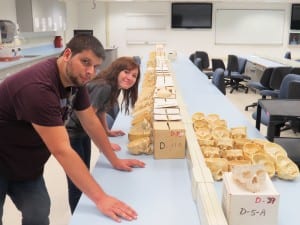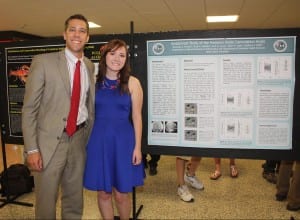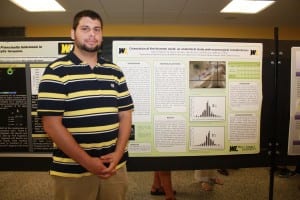WEST LIBERTY, W.Va., Aug. 5, 2015 — Scientific research done in WLU’s College of Sciences this summer included the study of skulls in the lab of Dr. Matthew Zdilla, associate professor of Biology and Physician Assistant Studies.
“This is the second year in a row that our skull morphology research took place. Last summer we collected anatomical specimens and created the database. This summer the imaging and analysis took place. It’s been very beneficial for our students to be involved in this research,” Zdilla said.

Scott Hatfield, Parkersburg, W.Va., and Kennedy McLean, Glen Easton, W.Va., are shown in the anatomy lab with the specimens that provided the research data.
The anatomical research will be helpful to neurosurgeons, Zdilla added, explaining that the result gives surgeons a better idea of how to approach procedures that require passage into the skull through the small holes (foramina) in the skull base.
A total of 82 skulls were analyzed and different images were taken using a high definition camera and computer program known as “ImageJ” that processes the images and analyzes the data.
Rising junior Kennedy McLean of Glen Easton, W.Va. is one of two students who did the research this summer. She took measurements and compiled data.
Since she’s majoring in human biology it was a perfect summer job for her.

Dr. Matt Zdilla congratulates Kennedy McLean on her research poster that summarizes her work in the anatomy lab.
“I hope to become a PA (physician assistant) so this was an ideal research project for me. I am grateful for the chance to take part in the summer research program at West Liberty,” she said.
Another biology major Scott Hatfield of Parkersburg, W.Va., also worked on the skull study this summer. Hatfield will graduate in the fall of 2016 and also hopes to enter WLU’s physician assistant studies master’s program.
“Working with the natural holes in the skull specimens, our research measured their orientation and shape characteristics. We measured a total of 157 foramina. The project was very interesting and adds an important research experience to my resume,” he said.
The research will help surgeons to biopsy tumors inside the skull, insert electrodes into the skull to measure brain activity in individuals with epilepsy, and treat painful conditions that affect the trigeminal nerve.
The 2014 summer research was published in two scientific journals, Surgical Neurology International and Anatomy & Physiology. And this summer’s research is now being peer reviewed for the Journal of Craniofacial Surgery.
“We also presented our research earlier this year at the national meeting of the American Association of Anatomists, held in Boston. I’m proud of all our students who have worked on this study and am confident that it will help them in their professions and future careers,” Zdilla said.
Last summer’s student researchers in the Zdilla lab were Leah Cyrus and Jillian Laslo. Cyrus and Laslo are entering their final year at WLU and both plan on careers in medicine, with Cyrus looking at optometry school and Laslo applying to physician assistant master degree programs.
The research was part of the Topper-SURE program that offers students interested in science careers a perfect way to strengthen their academic experience. Selected students work in research labs for eight weeks during the summer under the direction of a faculty research mentor.
Funded with support from the West Virginia Higher Education Policy Commission’s Division of Science and Research, Topper-SURE also pays each student researcher a $3,000 stipend along with a valuable research experience for their resume.
Dr. Robert Kreisberg is Dean of the College of Sciences which includes the departments of Health Sciences, Natural Sciences and Mathematics, and Physician Assistant Studies. For more information, please visit the College of Sciences webpage.
The post Skull Morphology Study Continues for Second Summer appeared first on News & Media Relations.
